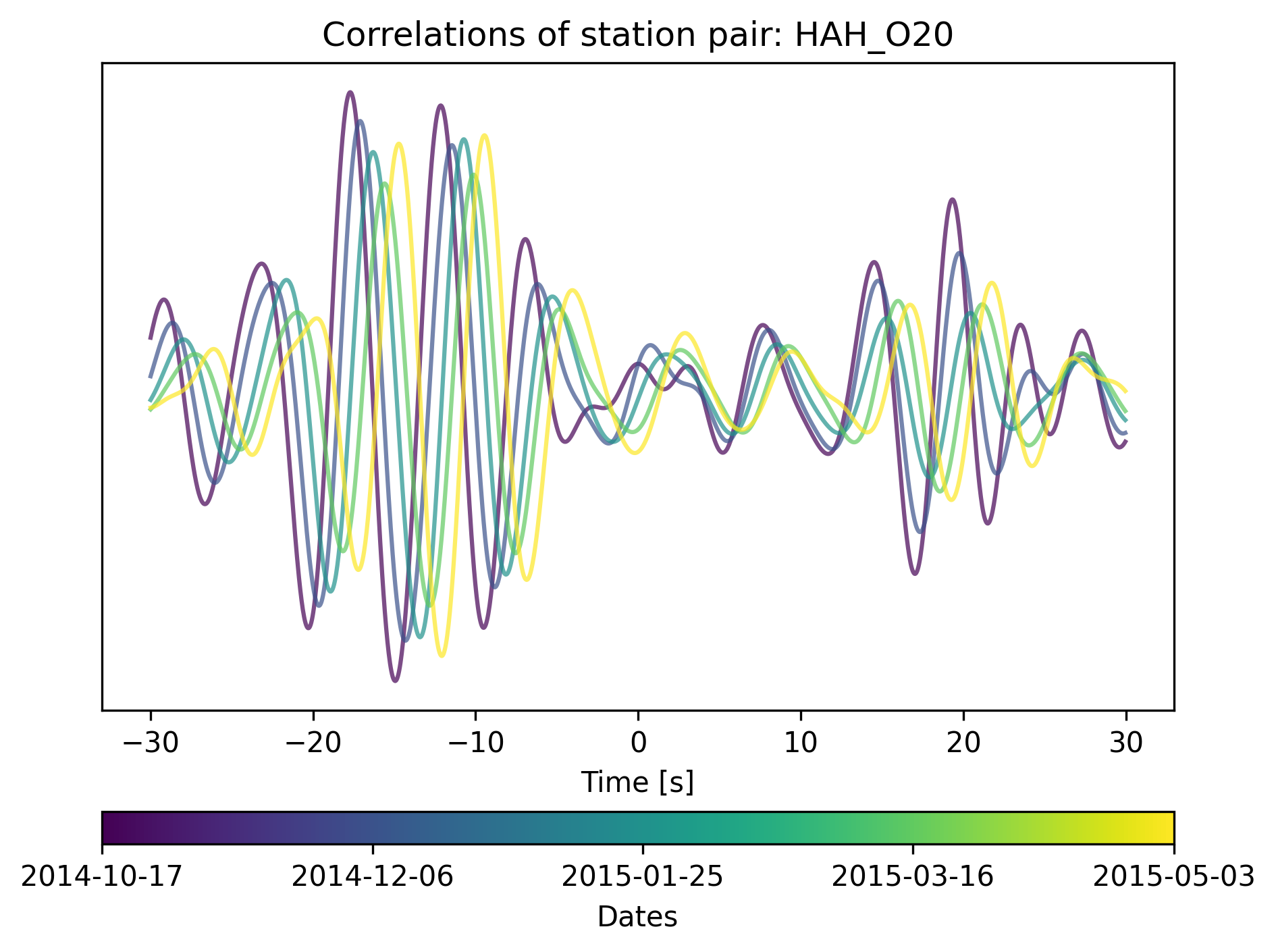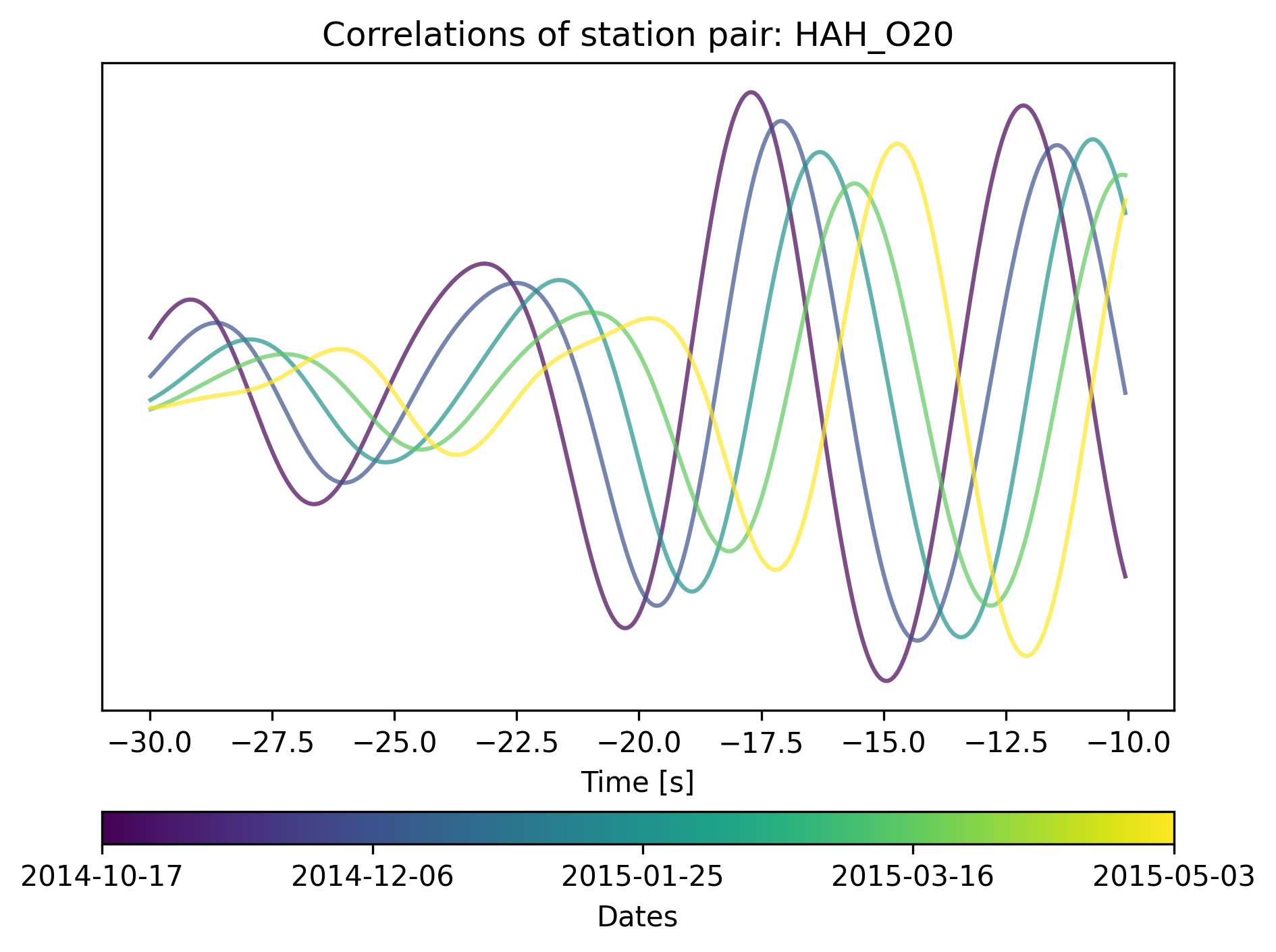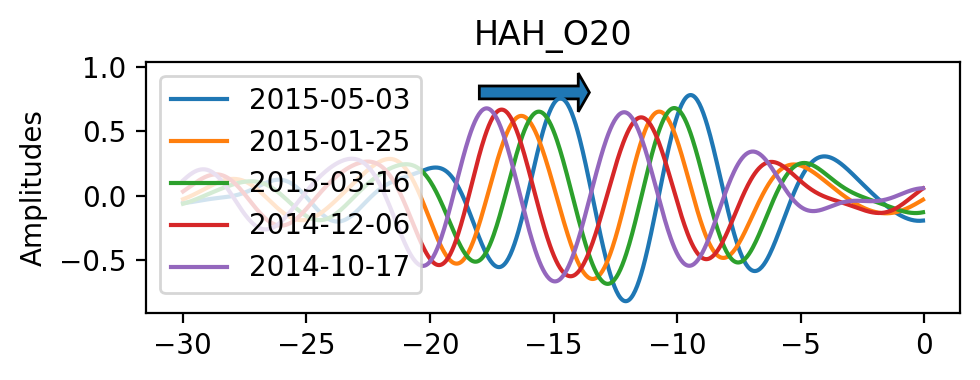2. Checking the data we loaded¶
Given that Github has a limited capacity to upload data, please request the dataset to David Naranjo (d.f.naranjohernandez@tudelft.nl). Then, change the path2datadir variable to the location of this folder in your computer.
[1]:
import matplotlib.pyplot as plt
from pprint import pprint
from ocloc import ProcessingParameters, ClockDrift, trim_correlation_trace
[2]:
# Parameters for locating the files where the correlation files and station
# information is contained.
path2data_dir = "/Users/localadmin/Dropbox/GitHub/data"
# path2data_dir = "/Users/localadmin/Dropbox/GitHub/ocloc/tutorials/correlations_O20"
station_file = "/Users/localadmin/Dropbox/GitHub/ocloc/tutorials/station_info"
reference_time = '2014-08-21T00:00:00.000000Z'
params = ProcessingParameters(
freqmin = 0.2, # Low freq. for the bandpass filter
freqmax = 0.4, # High freq. for the bandpass filter
ref_vel = 4500, # m/s
dist_trh = 2.5, # Minimum station separation in terms of wavelength
snr_trh = 30, # Signal-to-noise ratio threshold
noise_st = 240, # start of the noise window.
dt_err = 0.004, # Sampling interval needs to be multiple of this value.
resp_details = False)
cd = ClockDrift(station_file, path2data_dir,
reference_time = '2014-08-21T00:00:00.000000Z',
list_of_processing_parameters=[params])
No correlation file found for station:O26
No correlation file found for station:#STK
[3]:
cd.get_correlations_of_stationpair("O14", "O19")
[3]:
[
Correlation object
Station 1: O14
Station 2: O19
Average date of CC: 2014-10-17T12:31:59.000000Z
Number of days: 100.0
Interstation distance in km: 10.666950451705901
Path: /Users/localadmin/Dropbox/GitHub/data/O14_O19_1413549119_100.sac
t_app: Not calculated yet.,
Correlation object
Station 1: O14
Station 2: O19
Average date of CC: 2014-12-06T12:31:59.000000Z
Number of days: 100.0
Interstation distance in km: 10.666950451705901
Path: /Users/localadmin/Dropbox/GitHub/data/O14_O19_1417869119_100.sac
t_app: Not calculated yet.,
Correlation object
Station 1: O14
Station 2: O19
Average date of CC: 2015-01-25T12:31:59.000000Z
Number of days: 100.0
Interstation distance in km: 10.666950451705901
Path: /Users/localadmin/Dropbox/GitHub/data/O14_O19_1422189119_100.sac
t_app: Not calculated yet.,
Correlation object
Station 1: O14
Station 2: O19
Average date of CC: 2015-03-16T12:31:59.000000Z
Number of days: 100.0
Interstation distance in km: 10.666950451705901
Path: /Users/localadmin/Dropbox/GitHub/data/O14_O19_1426509119_100.sac
t_app: Not calculated yet.,
Correlation object
Station 1: O14
Station 2: O19
Average date of CC: 2015-05-01T15:43:57.000000Z
Number of days: 92.0
Interstation distance in km: 10.666950451705901
Path: /Users/localadmin/Dropbox/GitHub/data/O14_O19_1430495037_092.sac
t_app: Not calculated yet.]
Now let’s just take as an example the cross-correlations between HAH and O20
[4]:
station1 = cd.get_station("HAH")
station2 = cd.get_station("O20")
It is possible to check all the information of the stations as:
[5]:
station2
[5]:
Station object
Code: O20
Index: 13
Project: IMAGE
Sensor type: PZ_OBS
Needs correction: True
Latitude: 63.68719
Longitude: -23.31253
Elevation: -109.0
a values: []
b values: []
2.1 Checking the cross-correlations of a given station pair¶
We can check the individual cross-correlations of the station pair using the functionget_correlations_of_stationpair(). This function returns a list of all correlations for a given station pair.
[6]:
correlations = cd.get_correlations_of_stationpair(station1.code,
station2.code)
correlations[0]
[6]:
Correlation object
Station 1: HAH
Station 2: O20
Average date of CC: 2014-10-17T11:50:32.000000Z
Number of days: 100.0
Interstation distance in km: 42.738685773417195
Path: /Users/localadmin/Dropbox/GitHub/data/HAH_O20_1413546632_100.sac
t_app: Not calculated yet.
The Correlation objects contain all the metadata of the cross-correlation files. If you want to check the different attributes you just need to do type a Correlation. and the attribute you want to access. You can check all the attributes of the object as:
[7]:
correlation1 = correlations[0]
print("Path to the directory of correlation is ")
pprint(vars(correlation1))
Path to the directory of correlation is
{'apriori_dt1': 'Not calculated yet.',
'apriori_dt2': 'Not calculated yet.',
'average_date': UTCDateTime(2014, 10, 17, 11, 50, 32),
'cpl_dist': 42738.68577341719,
'delta': 0.03999999910593033,
'dt_ins_station1': 'Not calculated yet.',
'dt_ins_station2': 'Not calculated yet.',
'file_path': '/Users/localadmin/Dropbox/GitHub/data/HAH_O20_1413546632_100.sac',
'length_of_file_s': 3599.96,
'npts': 90000,
'number_days': 100.0,
'processing_parameters': Processing Parameters Object:
Minimum frequency: 0.2
Maximum frequency: 0.4
Reference surface wave velocity: 4500.0
Minimum station separation in terms of wavelength: 2.5
Signal-to-noise ratio threshold: 30.0
Start of the noise window: 240,
'sampling_rate': 25.0,
'station1_code': 'HAH',
'station2_code': 'O20',
't_N_lps': 57.493425925925926,
't_app': 'Not calculated yet.'}
We can get an overview of the cross-correlations of the station pair as follows:
[8]:
cd.processing_parameters[0].freqmin=0.15
cd.processing_parameters[0].freqmax=0.3
cd.plot_correlations_of_stationpair(station1.code, station2.code,
min_t=-30, max_t=30)
cd.plot_correlations_of_stationpair(station1.code, station2.code,
min_t=-30, max_t=-10)


If we zoom in we can actually see how the interferometric responses are being shifted over time.
[9]:
from ocloc import read_xcorrelations
st, _ = read_xcorrelations(station1.code, station2.code, path2data_dir)
st = st.normalize()
min_t=-30
max_t=0
freqmin=0.15
freqmax=0.3
fig, (ax1) = plt.subplots(1, 1, figsize=(5, 2), dpi=200)
for tr in st:
# Trim the signal to use only the part we are interested at.
t1, data = trim_correlation_trace(tr, min_t, max_t, freqmin, freqmax)
# index of matching element
acausal_indixes = [idx for idx, val in enumerate(t1) if val > -22 and val < -10]
causal_indixes = [idx for idx, val in enumerate(t1) if val > 12 and val < 25]
ax1.plot(t1, data, label=str(tr.stats.average_date)[:10])
# Adding an arrow to graph starting
# from the base (2, 4) and with the
# length of 2 units from both x and y
# And setting the width of arrow for
# better visualization
plt.arrow(-18, 0.8, 4, 0, width = 0.1)
ax1.set_title(tr.stats.station_pair)
ax1.set_ylabel('Amplitudes')
ax1.legend(loc=2)
plt.tight_layout()
